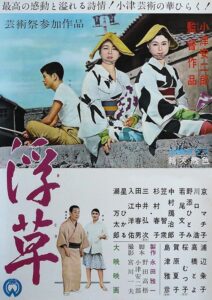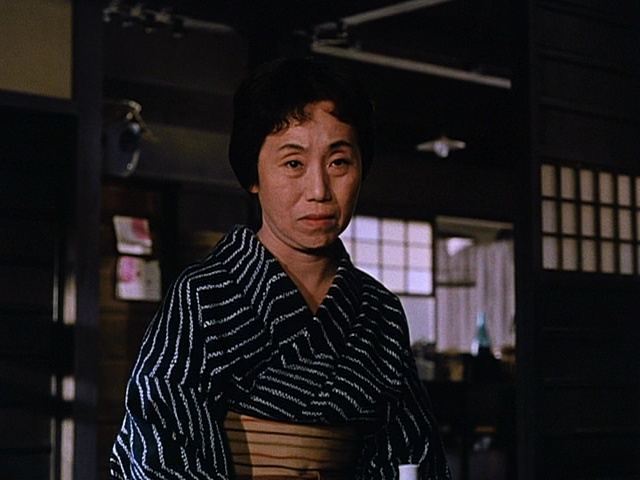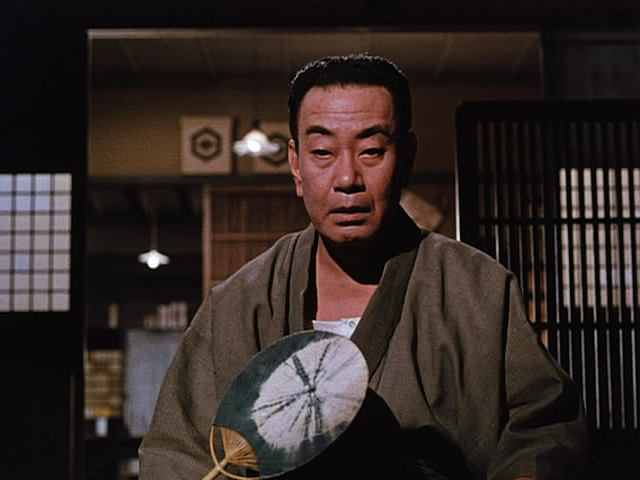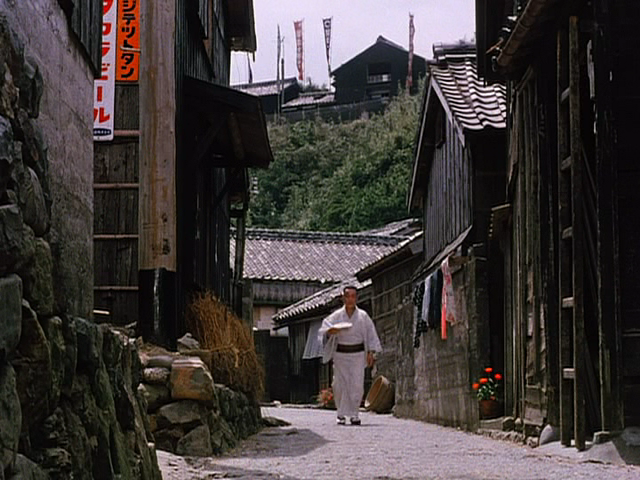|

Synopsis:
When touring in a seaside village, the manager (Ganjiro Nakamura) of an itinerant acting troupe visits his former lover (Haruko Sugimura) and their grown son Kiyoshi (Hiroshi Kawaguchi), who believes Komajuro (Nakamura) is his uncle. Komajuro’s mistress (Machiko Kyo) becomes jealous when she learns about this, and asks her colleague (Ayako Wakao) to seduce Kiyoshi — much to Komajuro’s distress.
|
|
Genres, Themes, Actors, and Directors:
- Actors and Actresses
- Grown Children
- Japanese Films
- Jealousy
- Mistaken Identities
- Revenge
- Yasujiro Ozu Films
Review:
One of the final films made by the prolific Japanese director Yasujiro Ozu before his death in 1963, Floating Weeds remains a critical favorite, with Roger Ebert notoriously placing it among his personal “top 10”. A remake of Ozu’s 1934 silent film The Story of Floating Weeds (which I haven’t seen, and which isn’t listed in Peary’s book), the storyline reveals Ozu’s enduring interest in the drama of familial relations, embedded within the specific context of a struggling Kabuki theatrical troupe (the phrase “floating weeds” is, according to Ebert, a Japanese term for itinerant actors). The actors are all fine in their respective roles, with Kyo — perhaps best known for her role as the violated wife in Kurosawa’s Rashomon (1950) — giving a particularly nuanced performance as Nakamura’s jealous, vulnerable mistress.
Fans of Ozu’s distinctive directorial style — including low, static camera angles; exclusive use of a 50 mm lens; no fades or dissolves between shots; and the steady incorporation of pillow shots between scenes — will find much here to enjoy and admire. The leisurely pace of the film — punctuated by fits of violence and melodrama — allows much time for contemplation and appreciation of the vibrant color scheme and authentic seaside settings. Yet while I was curious to learn how things would resolve between Nakamura and his son, his lover, his former lover, and his son’s lover, the storyline moves awfully slowly, wandering aimlessly at times to focus on numerous (perhaps too many?) side-plots. With that said, most film fanatics will surely want to check out this highly regarded film by Ozu, so I’m strongly recommending it for at least one-time viewing.
Note: Of Ozu’s 54 films, Peary curiously only lists four in his GFTFF. All — Late Spring (1949), Early Summer (1951), and Tokyo Story (1953) — have now been reviewed on this site.
Redeeming Qualities and Moments:
- Haruko Sugimura as Oyoshi

- Machiko Kyo as Sumiko

- Ganjiro Nakamura as Komajuro

- Vibrant cinematography

- Fine use of authentic seaside locales

Must See?
No, though it’s strongly recommended. Listed as a Personal Recommendation in the back of Peary’s book.
(Listed in 1001 Movies You Must See Before You Die)
Links:
|






One thought on “Floating Weeds / Drifting Weeds (1959)”
Not a must; rather in agreement, overall.
Most of Ozu’s major films, as well as some of his minor ones – all from around the early ’40s on – could very well be of interest to ffs. Certainly Peary could have included several other Ozu titles in his FF book.
But some of Ozu’s latter films in particular, though well made and with specific charms, can feel less memorable. ‘Floating Weeds’ is one of them. What’s most noticeable about ‘FW’ is that it plays like a typical woman’s picture with – oddly – a stubborn male protagonist standing in.
As noted, the film is certainly nice to look at, with pleasing color schemes and relaxing locales. After seeing so much of Ozu’s work in b&w, it’s a bit refreshing to watch him work in color. (I esp. like the shots during rain showers – in particular, the one in which Nakamura and Kyo have their first argument.)
Of the actors, Nakamura is really the only one allowed to take forceful command, but then it’s his movie – and his performance is admirable. FFs familiar with some of the other acting credits of Sugimura (inc. several Ozu films), Kyo (‘Street of Shame’ with Wakao, etc.) and Wakao (esp. ‘A Geisha’) will note their restraint here – and may prefer them in roles in which they are wrapped less tight. (Kyo does get a bit of a chance to let loose here, but many of her scenes involve her being jealous – which can be one of the least interesting emotions to play on-screen, depending on its purpose).
I actually like the fact that ‘FW’ has a few sidelines (tho I wouldn’t call them subplots); these make for some welcome surprises and bolster the thin plot. ~although *all* Ozu films have thin plots, really – the challenge for him had always been in pulling out layers in simple storylines.